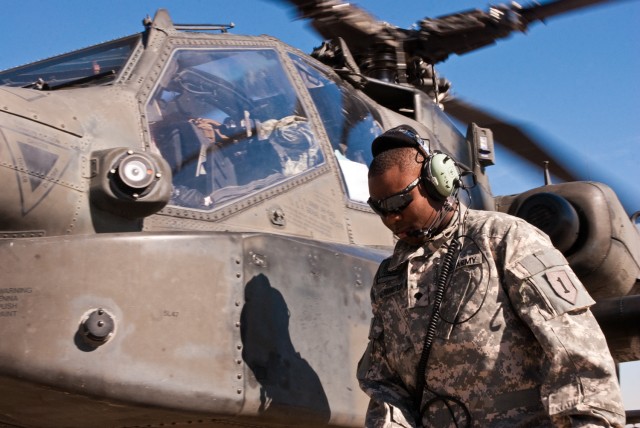CAMP TAJI, Iraq - Like a NASCAR race team, half of an Apache attack helicopter crew never takes the white-knuckled ride out of the pits.
The $35 million, twin-engine, missile toting Apache is designed to seat no more than it takes to get its job done, and its crew chiefs stay on the ground as the birds lift off. But like its distant, less lethal cousins in the racing world, the Apache could not fly without the efforts of its ground crew.
These crews are especially busy in Iraq, serving with the 1st Attack Reconnaissance Battalion, 1st Aviation Regiment, a unit in high demand as the only Apache battalion deployed here.
"The pilots do the hardest job, flying the long hours, but they couldn't make that mission without their aircraft," says Spc. Sean Hillery, 36, of Modesto, Calif.
Crew chiefs like Hillery make certain the aircraft are able to make that mission. Over the last nine months, the battalion has kept an average of 80 percent of their aircraft fully mission capable, 5 percent over the Army's standard.
Hillery, who worked as a construction manager before he joined the Army two years ago, and like most of the battalion's crew chiefs, says he has spent most of his life "tinkering on something or another."
Before they become crew chiefs, the enlisted ground crews work in maintenance hangars as electricians and mechanics whose workload could intimidate even the most experienced wrench-turners.
"When you think of cars and horsepower, this thing is amazing in comparison," says Spc. Evan Hart, 25, of Dawson, Pa. "By the time the torque comes from the engine to spin the blades, it's over 4,600 pounds of torque. The engines themselves put out 1,900 horsepower each."
Crew chiefs like Hillery and Hart are not only responsible for maintaining the aircraft, but also inspecting its systems and helping pilots prepare for missions. When an Apache leaves or returns, crew chiefs stand by to help the pilots, perform rapid troubleshoots, and conduct preflight and post flight checks.
The crew chiefs tend to more than the aircraft's needs, says Hart.
"We take care of the pilots, too," said Hart. "We're there to get them out if something goes wrong, and we make sure they're safe when they get in the aircraft."
Outside the Apache's immediate team of pilots and crew chiefs, other enlisted personnel do their part to keep the aircraft in the air.
Spc. Alex Knapp, 21, of Owasso, Okla., is an Apache armament, electrical, and avionics systems repairer. Knapp and his peers work alongside the Apache crew chiefs, specializing in some of the aircraft's more technical aspects - aspects Knapp says are the "bread and butter" of making the Apache work.
"Sometimes you've got to get down in tight spots that aren't exactly comfortable, but loading rounds into the gun, loading the missiles, the rockets...this is a great job, well worth it," says Knapp.
The battalion has not fired nearly as many rockets as they have on past deployments, says Knapp. In Operation New Dawn, its Apaches are lending their muscle to what the military calls stability operations, providing security as the Iraqi government gets on its feet. The mission has not changed, however, for the unit's ground crews.
"Like any computer, it will turn on and break eventually," says Hart, "and then we fix it."




Social Sharing